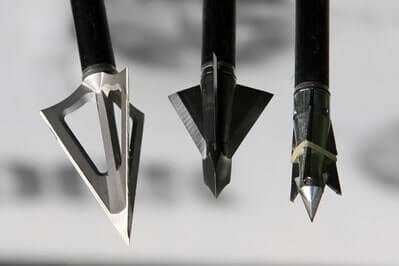Disclosure: We may earn commissions if you purchase products after clicking on a link from our site.
Are you searching for the best broadheads for deer? Do you want broadheads with maximum accuracy and penetration? How successful you are when bowhunting is partly due to the broadhead that you use. A broadhead with pinpoint accuracy and penetrating power will deliver the shock and lethal blow to take down the game animal. In this article, we shared some of the best broadheads for deer to help you choose the right one for your bowhunting trips.
Table of Contents
- 0.1 1. Sinbadteck Hunting Broadheads
- 0.2 2. Muzzy Bowhunting Broadheads
- 0.3 3. Jocoo Hunting Broadheads
- 0.4 4. NAP Thunderhead Broadhead Set
- 0.5 5. Rage Extreme Broadheads
- 0.6 6. NAP Spitfire Broadhead
- 0.7 7. OTW Hunting Broadheads
- 1 Types of Broadheads
- 2 What To Consider When Choosing a Broadhead
- 3 Best Broadheads For Deer
- 4 The Bottom Line
1. Sinbadteck Hunting Broadheads
This hunting broadhead is easy to use and high-performance broadhead. It features 2.8-inch stainless steel blades for hunting. It is durable, sharp, and fast. This broadhead also features 100-grain broadheads with 3 sharp fixed blades. This broadhead is compatible with all traditional and compound bows.
What We Like:
Durable
Razor-Sharp
Fast
Compatible
2. Muzzy Bowhunting Broadheads
- Stainless Steel
- Razor-Sharp
- Durable
- Easy To Use
- Fast
This broadhead features hardened Muzzy Trocar tips for maximum penetration and enhanced flight stability. It is a 100-grain broadhead with 3 razor-sharp stainless steel blades that feature a 1 3/16 inch cutting diameter, and a .020 inch blade thickness.
What We Like:
Stainless Steel
Razor-Sharp
Durable
3. Jocoo Hunting Broadheads
This broadhead is a 100-grain, 3-blade broadhead that will help you take down more game during the hunting season. It is durable, razor-sharp, and easy to use. It is 2.82 inches in length and 1.035 inches in width. It is compatible with crossbows and compound bows.
What We Like:
Easy To Use
Durable
Razor-Sharp
4. NAP Thunderhead Broadhead Set
This 5-piece broadhead set is available in 85, 100, and 125-grain options. Its micro-grooved ferrule increases flight accuracy and penetration power. It is razor-sharp thanks to the Diamize sharpened blades.
What We Like:
Flight Accuracy
Razor-Sharp
Durable
Easy To Use
5. Rage Extreme Broadheads
This broadhead is ideal for hunters as it delivers a lethal blow to game animals to take them down. It delivers sizable entry and exit wounds which will result in a recognizable blood trail to track down the wounded animal.
It is a.030-inch thick single-piece, 7/8-inch cut-on-contact tip, and two double-bevel .035-inch expandable wing blades that span 2.3 inches across that produce quick kills. This is a 2-pack 100-grain broadhead.
What We Like:
Durable
Easy To Use
6. NAP Spitfire Broadhead
The Spitfire broadhead delivers accuracy and shock to quickly take down the target. It flies straight with pinpoint accuracy to deliver a deadly blow. Additionally, its blades are razor-sharp thanks to the Diamize sharpening process.
What We Like:
Pinpoint Accuracy
Razor-Sharp
Durable
Easy To Use
7. OTW Hunting Broadheads
This broadhead is a 100-grain broadhead that delivers a true and accurate fly. It is durable and reliable with all-steel construction and 1-inch sharp blades. It works for compounds and crossbows. The OTW broadhead is rugged and will penetrate deep into the animal and quickly take it down.
What We Like:
Durable
Deep Penetration
Easy To Use
Types of Broadheads
- Fixed-blade Broadheads
Fixed-blade broadheads have immovable blades. They are permanently fixed onto the arrow shaft. Some are designed with a screw-in design. Fixed-blade broadheads are popular with many traditional bowhunters who use bows with lower draw weights.
2. Mechanical Broadheads
Mechanical broadheads are not the best option when you want accuracy and maximum penetration as some of the energy is dissipated during the opening of the blades. Moreover, they are prone to different failures as they are mechanical. Mechanical blades are recommended for bows that weigh 50 pounds or more.
3. Removable Blades
The removable blade broadhead is designed in a way that the blades are replaceable on the ferrule. This allows only the blades to be replaced if they are damaged. The entire broadhead doesn’t need to be replaced.
What To Consider When Choosing a Broadhead
- Blade Material
Stainless steel and high-carbon steel or titanium are the main types of materials used for broadheads. Stainless steel has the strength to penetrate the game animal, even break a bone, to deliver a fatal blow to almost drop it dead in its tracks.
High-carbon steel is another good option but is not as strong as stainless steel to deliver the shock to quickly kill the animal. However, it is less likely to experience corrosion which keeps the blade sharp for a longer period of time.
2. Cutting Diameter
The cutting diameter is another factor to consider when choosing a broadhead. There is a perpetual debate among bowhunters as to whether large or small cutting diameters are better for broadheads. Actually, both sizes have some good points. Large cutting diameters will do more damage to the internal organs, and blood vessels to quickly drop the animals. On the other hand, small diameters encounter less friction when penetrating the animal.
3. Weight
The weight of the arrow, including the weight of the broadhead, is also an important factor to take into consideration when choosing a broadhead. The weight of the broadhead is measured in grains. One grain equates to about 65 milligrams.
A light broadhead will fly fast and will cover more distance and be more accurate over a longer range. Heavier broadheads; however, will penetrate the game animal more easily than a lighter broadheads. If you are an experienced bowhunter with a compound bow or crossbow, opt for heavier broadheads. If you are a beginner bowhunter, with a traditional bow or crossbow, lighter broadheads may be the best choice for you at this time.
4. Accuracy
The accuracy of the broadhead is also another important factor when choosing a broadhead. The accuracy of the broadhead will depend on whether it is a fixed-blade broadhead or a mechanical broadhead. A fixed-blade broadhead that is designed with slightly offset blades makes it fly consistently and accurately.
Mechanical broadheads, on the other hand, due to their design, allow you to practice and improve your accuracy. However, mechanical broadheads are less consistent than fixed-blade broadheads. If you are using mechanical broadheads, go with ones that have more stable mechanisms.
5. Sharpness
The sharpness of the broadhead is also very important. It will partly be responsible for how quickly the broadhead penetrates the animal and causes damage to drop the animal. Razor-sharp broadheads are always the best choice. There are broadheads that can be resharpened to keep them in a good condition for bowhunting.
6. Durability
Durability is another important factor to consider when choosing a broadhead. A durable broadhead is not only long-lasting but will perform better to deliver a lethal blow to quickly take the game animal down. You want broadheads that are constructed of durable materials that are bone-crushing. Stainless steel broadheads are stronger than aluminum broadheads and they won’t easily bend.
7. Ferrule
The ferrule is also a very important factor. When choosing a broadhead, make sure that it has a ferrule designed to allow maximum airflow over the blades. The characteristics of an aerodynamic ferrule with a heavy broadhead can deliver a lethal blow to game animals.
Best Broadheads For Deer
| SiteStripe Image | Title | Buy |
|---|---|---|
| Sinbadteck Hunting Broadheads | Check Price On Amazon | |
| Muzzy Bowhunting Broadheads | Check Price On Amazon | |
| Jocoo Hunting Broadheads | Check Price On Amazon | |
| NAP Thunderhead Broadhead Set | Check Price On Amazon | |
| Rage Extreme Broadheads | Check Price On Amazon | |
| NAP Spitfire Broadhead | Check Price On Amazon | |
| OTW Hunting Broadheads | Check Price On Amazon | |
| VNAKER Hunting Broadheads | Check Price On Amazon | |
| NAP Spitfire Double Cross Broadhead | Check Price On Amazon | |
| e5e10 Hunting Broadheads | Check Price On Amazon | |
| Flying Arrow Broadhead | Check Price On Amazon |
The Bottom Line
The broadheads you use for hunting deer are very important. It can determine the accuracy and degree of penetration to quickly drop the game animal. There are many different types of broadheads available today. We reviewed some of the best broadheads to help you find the right one for your bowhunting expeditions.
If you are interested in getting crossbows, then read a review of the best hunting crossbows. You can also get a few tips on hunting deer with a crossbow when you read how to hunt deer with a crossbow.

